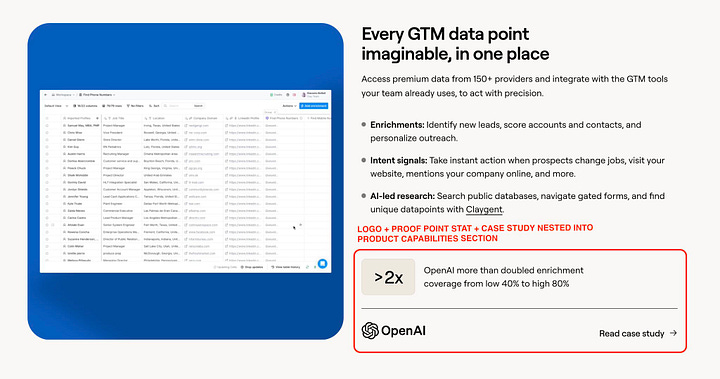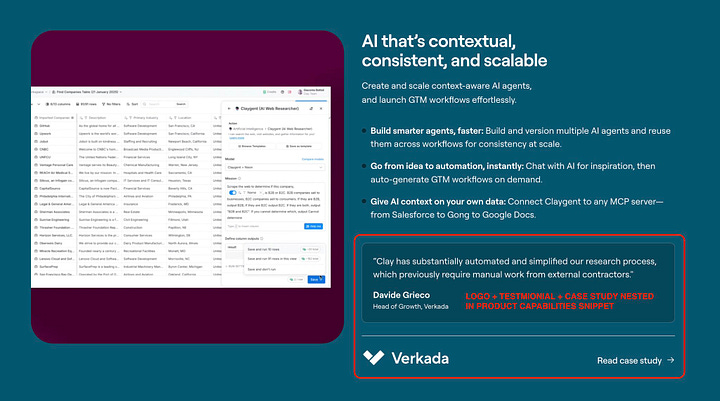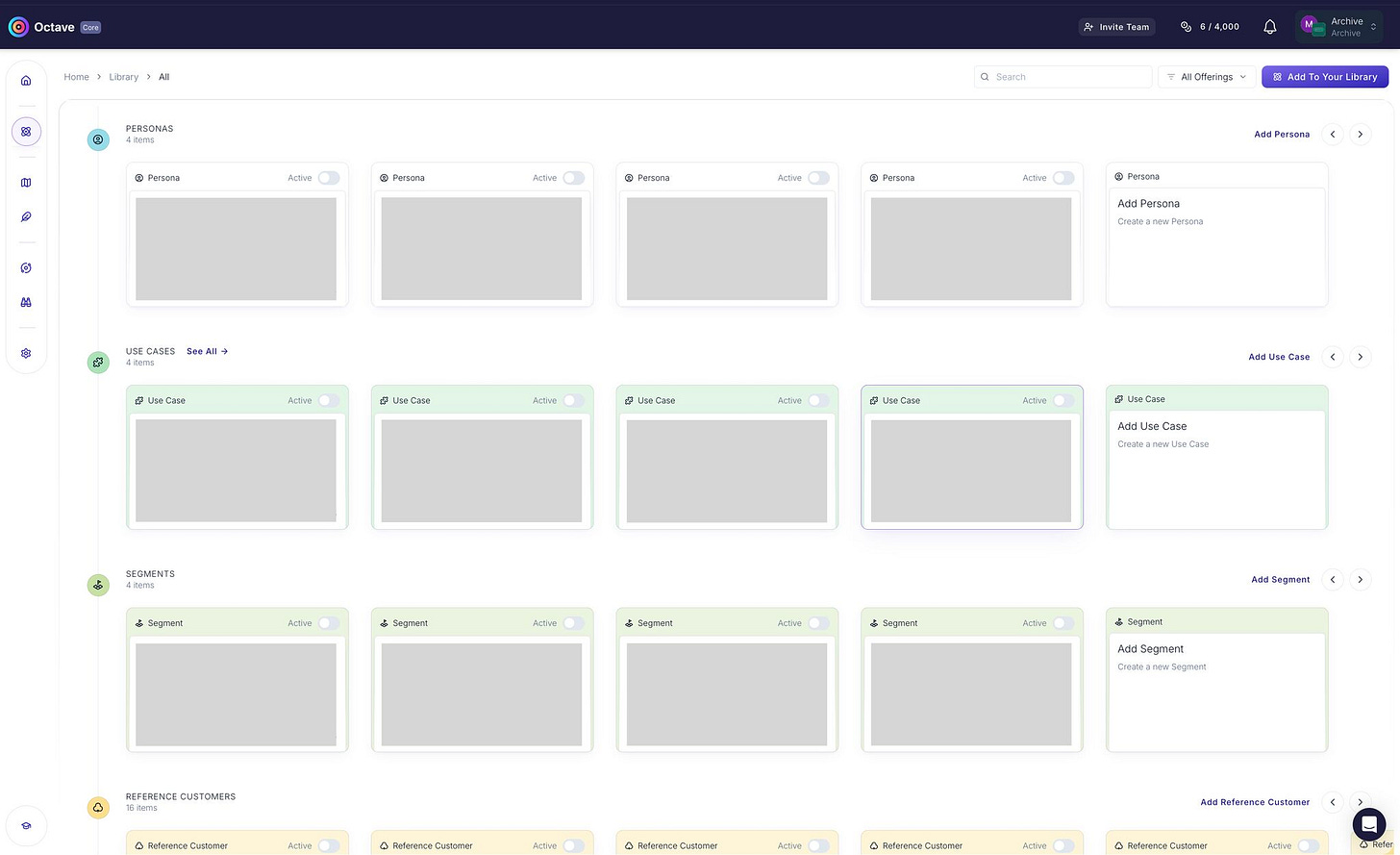What I recommend in every engagement
I worked with 19 Seed-to-Series C startups in the last 12 months on GTM, PMM, and content. Here are the things I now suggest in every engagement.
I worked with 19 Seed-to-Series C startups in the last 12 months on GTM, PMM, and content. Here are the things I now suggest in every engagement.
↓↓↓
1. BUILD A MESSAGING & POSITIONING LIBRARY IN Octave
I do this first because this library forms the context engine for every campaign, landing page, and assets I create. It has:
↳ Product messaging: capabilities, benefits, differentiators
↳ ICP, segments, and use cases model
↳ Competitors, customer references, proof points
The best part is that you can build it for free in <1h (with the right inputs).
Octave is great not just for starting out with messaging/positioning, but also for:
↳ Keeping things consistent across outbound/content channels
↳ Adding messaging when introducing new products/segments/personas
↳ Re-positioning or re-messaging against new competitors/categories
2. EXPORT YOUR OCTAVE LIBRARY AS LLM KNOWLEDGE
I export Octave library as a Google Doc and feed it to AIs.
↳ GPT/Claude/Manus AI/n8n: Context for long-form/enablement assets
↳ AirOps → Knowledge base for SEO/content (optimization) workflows
↳ Scripe → Create GOOD LinkedIn ideas/posts with ~one-shot
↳ Clay → Create landing pages at scale (also call content agents directly)
This way content is always grounded in deep ICP, product, competitors knowledge — and writing styles (I have a custom GPT to generate those).
3. EXPAND YOUR LANDING PAGE FOOTPRINT
Must haves these days:
↳ Product/use case pages to explain what you do (in details)
↳ Persona/Solutions pages to call out your buyer personas/segments
↳ Comparison pages to compare you with alternative/status quo
↳ Integration pages to show how you fit into your buyers’ stack
SaaS hardly have one competitors/personas/use cases these days, that’s why you need to some extent most if not all of the above!
These work as PMM/positioning assets, but also for AI/SEO coverage.
And you can scale these very easily and WELL with Octave + LLMs.
With one client, I’ve recently created 500+ competitors pages with Octave + Clay + Webflow. It took about ~2.5 months of work.
4. STACK MULTIPLE SOCIAL PROOF MARKERS
Social proof has never been more table stakes, and required across multiple formats and placements.
You MUST collect LOTS of logos, testimonial, reviews, proof points, and case studies. Don’t wait on it. And SHOW it ALL — preferably above the fold.
↳ Above the fold logo + case study + testimonial on hover
↳ Testimonial + proof stats nested in product sections
↳ G2/SOC2 badges + stars + scale markers (eg. trusted by 50k+ orgs)
Clay does this super well on their website (see below).
I die a little bit every time I see logos below the fold.




5. START POSTING ON SUBSTACK + LINKEDIN YESTERDAY
Own 1 category-related word (these days better with “AI” as a prefix), and start sharing your POV about it. Your real experience, your own thoughts, your own point of view. Just share how you see things.
My fave people doing this are Austin Hughes, Brendan Short (thx for inspiring this post ;), Emir Atli (Hiring AEs and SDRs), Stan Rymkiewicz, Linda Lian, Kevin Indig, Kyle Poyar, David Fallarme, Maja Voje.
And you HAVE TO do long-form too — piggy-back off writers in your niche with large audiences. If you’re not on the map, people won’t buy from you!
6. USE VISUAL IDENTITY/DESIGN AS A BRAND DIFFERENTIATORS
Your looks matter A LOT more than what you think on your perception of trust and end up.
Best examples for me are Clay, Linear, Anthropic.
↳ Clay infuses actual clay-ness into their iconography
↳ Anthropic stands out among “robotic players” with their humane doodles
↳ Linear proudly owns their hyper-minimalist, hyper-refined dark mode



Invest time to THINK about your ICP, your ALTERNATIVE, and how you can come across as DIFFERENT not just in your product/copy, but also in your look/feel. It’s a more blue ocean than you think.
Want to build your product marketing foundations? I’ve helped 40+ Seed-to-Series C build their messaging, website presence, and content. Book a call with me to collaborate.
7. KEEP A TASTE SWIPE FILE OF CREATORS, BRANDS, COMPETITORS
Make a simple list — competitors, accounts, websites, campaigns, creators — that defines GOOD looks like for you (and your ICP).
Use it as training data for LLMs, and run comparative analysis to identify gaps + opportunities for your campaigns (Manus AI is great for this).
8. CONNECT + COMMENT WITH YOUR ICP DAILY
Connect manually with up to 100 ICP connections per week (200 with premium). That’s ~500 new connections per month, and the more you connect the more the algo gives you ICP-like connection suggestions.
Everyone says this, but no one does it — comment on posts from your target buyers. It doesn’t just give you extra reach, but it keeps you current, makes your name top-of-mind beyond just posting.
BUT DON’T do AI here 😡



